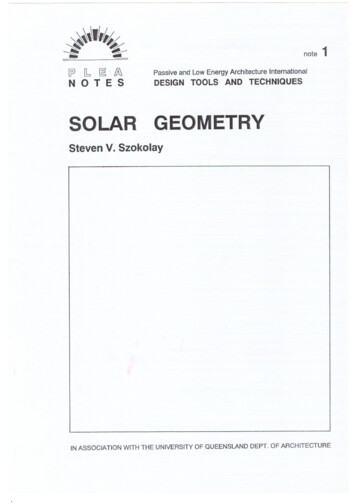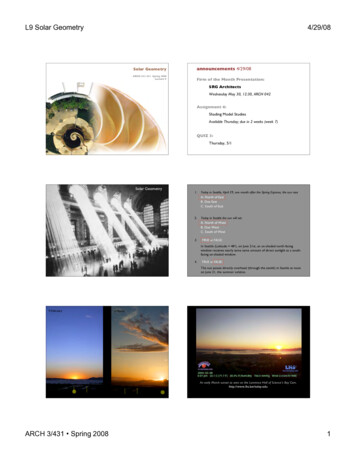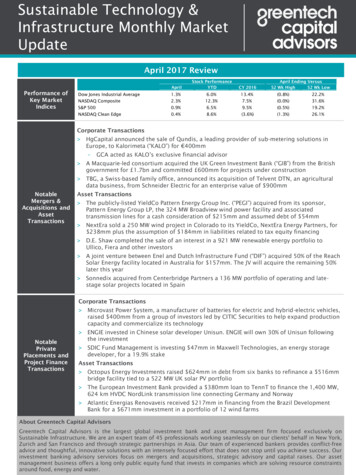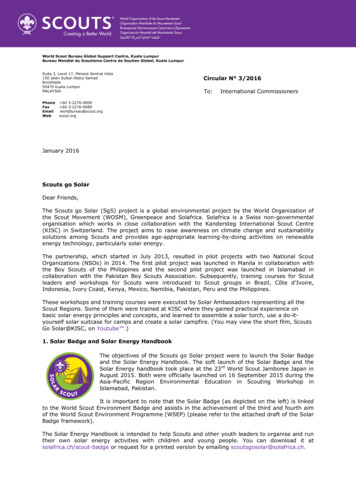
Transcription
.
SOLAR GEOMETRY S V Szokolayall rights reservedfirst published1996second revised edition 2007by PLEA: Passive and Low Energy Architecture Internationalin association withDepartment of Architecture, The University of QueenslandBrisbane 4072The author, Steven Szokolay was Director of the Architectural Science Unit andlater the Head of Department of Architecture at The University of Queensland- now retired. He is past president of PLEA; has a dozen books and over150 papers to his credit.The manuscript of this publication has been refereed byBruce Forwood, Head of Department of Architectural ScienceUniversity of SydneyandSimos Yannas, Director, Environment and Energy Studies ProgrammeArchitectural Association, Graduate School, LondonISBN 0 86766 634 4
SOLAR GEOMETRYPREFACEPLEA (Passive and Low Energy Architecture) International is a world-widenon-profit network of like-minded professionals. It was founded in 1981 andsince then its main activities were the organisation of annual conferences,publication of the proceedings and the running of design competitions.PLEA has six directors (each serving for six years, one replaced annually)but no formal membership. Associates are created by invitation and serveas regional nodes of the network.PLEA is committed toecological and environmental responsibility in architecture andplanningthe development, documentation and diffusion of the principles ofbioclimatic design and the application of natural and innovativetechniques for heating, cooling and lightingthe highest standard of research and professionalism in buildingscience and architecture in the cause of symbiotic humansettlementsserve as an international, interdisciplinary forum in fostering thediscourse on environmental quality in architecture and planninghelp to solve architectural and planning problems, wherever itscollective expertise may be appropriate.The 1993 Chicago Congress of the International Union of Architects issuedthe Declaration for Interdependence for a Sustainable Future. PLEAprinciples are gaining ground. This Declaration provides a usefulframework, the essential skeleton. We see our task now in putting themuscles on the skeleton, in providing assistance for the realisation of theseprinciples.The directorate realised that good textbooks are very expensive; fewstudents can buy them. To overcome this problem and to assist thedevelopment of competence, we decided to produce a series of PLEANotes, with the generic title: Design Tools and Techniques. With theassistance of the University of Queensland, Department of Architecture wewill be able to supply these A4 size booklets at very favourable prices.To the second editionThe problem with the first series of these notes was that they were toocheap. [This was due to some people putting in much labour of love andto the assistance of the Department in using the university facilities. Withthe changing times (and management) this is no longer possible.] Thepostage often was more expensive than the printed product. Thereforethe Directors decided to make these Notes available on the web. Thisgave us the opportunity to revise, correct and update these texts, and alsomake available some simple computer programs developed since the firstpublication. Both the Note and the program can be downloaded.Instructions for using the program are included in this Note.Any comments or suggestions are welcome by the editor:Steven V. Szokolay50 Halimah St. Chapel Hill, 4069 Australia s.szokolay@uq.edu.au 1
SOLAR GEOMETRYContentsINTRODUCTIONpageabbreviations1 Earth-sun relationship1.1 Heliocentric view1.2 Lococentric view1.3 Time2 Graphic representation2.1 Apparent sunpaths2.2 Sunpath diagrams2.3 Vertical projections112.4 Gnomonic projections3 Shading design3.1 Shadow angles3.2 The shadow angle protractor3.3 The design process3.4 A worked example3.5 Overshadowing4 Algorithms4.1 Declination and equation of time4.2 Solar position angles4.3 Sunrise4.4 Shadow angles4.5 Angle of incidence5 Sunpath diagrams5.1 Description5.2 The program “ShadeDesign”5.3 A worked example- ReferencesAPPENDIX1 Derivations of solar angle equationsA1.1Solar altitudeA1.2Solar azimuthA1.3Derivations by planar geometryA1.4Sunrise and sunsetA1.5Shadow anglesA1.6Angle of incidenceReferences for the derivations2 Construction of sun-path diagrams3 Some further applications:A3.1sun penetrationA3.2sideways extent of canopy4 Model 13132333636383838404142452
SOLAR GEOMETRYINTRODUCTIONIn the thermal- (climatic-) design of buildings the sun is one of the mostimportant influences. Solar radiation entering through windows gives adesirable heating effect in winter, but it can cause severe overheating insummer. The assessment of its availability and its control are very importantparts of architectural design.Quantitative treatment of solar radiation is outside the scope of thepresent text (it will be the subject of a future Note) - this one is restricted tosolar geometry.The present work has two objectives:1to give an understanding of the geometrical relationshipbetween the earth and the sun, thus to establish aconceptual background2to provide a working tool for the design of shading devices,for the assessment of overshadowing and sun penetrationinto buildings.The first section presents the basic relationships and the second sectiondiscusses the various methods of graphic representation: homing in on thestereographic projections. Section 3 is probably the most practically usefulpart, its subject being shading design and it includes some workedexamples. Section 4 gives a series of algorithms for the calculation ofvarious solar angles. Section 5 describes the stereographic sun-pathdiagrams with the shadow angle protractor and introduces the programShadeDesign , that can be downloaded from the PLEA web-site.For those with an inquisitive mind the derivations of these algorithms ispresented in Appendix 1. Further appendices give the constructionmethod for the sun-path diagrams and describe some further applicationsand uses of these diagrams.Note that in the text some of the diagrams and examples are given for thesouthern hemisphere, some for the northern. This is quite deliberate: itshould assist in developing a global view.3
SOLAR GEOMETRYABBREVIATIONSIn many texts Greek letters are used to denote the variousangles. Here the practice of some of my earlier publicationsis continued: using 3-letter abbreviations rather thensymbols. I found that these are more readily rememberedand this avoids confusion with other terms denoted byGreek TILVSAZENsolar altitude anglesolar azimuth anglesolar declinationequation of timehour-anglehorizontal shadow angleangle of incidencegeographical latitudenumber of day of yearorientation (building face azimuth)sunrise azimuth anglesunrise hour-anglesunrise timesunset timetilt angle (from the horizontal)vertical shadow anglezenith angle4
SOLAR GEOMETRY1EARTH - SUN RELATIONSHIP1.1Heliocentric viewThe earth is almost spherical in shape, some 12 700 km in diameter and itrevolves around the sun in a slightly elliptical (almost circular) orbit. Theearth - sun distance is approximately 150 million km, varying between152 million km (at aphelion, on July 1) and147 million km (at perihelion, on January 1)The full revolution takes 365.24 days (365 days 5 h 48’ 46” to be precise)and as the calendar year is 365 days, an adjustment is necessary: oneextra day every four years (the ‘leap year’). This would mean 0.25 days peryear, which is too much. The excess 0.01 day a year is compensated by aone day adjustment per century.Fig.1The Earth’s orbitThe plane of the earth's revolution is referred to as the ecliptic. The earth'saxis of rotation is tilted 23.45o from the normal to the plane of the ecliptic(Fig.1). The angle between the plane of the earth's equator and theecliptic (or the earth - sun line) is the declination (DEC) and it variesbetween 23.45o on June 22 (northern solstice) and -23.45o on December22 (southern solstice, Fig.2).Fig.22-D section of the earth's orbit, showing the two extreme declination anglesOn equinox days (approximately March 22 and Sept.21) the earth - sunline is within the plane of the equator, thus DEC 0o. The variation ofdeclination shows a sinusoidal curve (Fig.3).Fig.3Fig.4 Definition of geographical latitudeAnnual variation of declination (mean of the leap-year cycle)Geographical latitude (LAT) of a point on the earth's surface is the anglesubtended between the plane of the equator and the line connectingthe centre with the surface point considered.5
SOLAR GEOMETRYPoints having the same latitude form the latitude circle (Fig.4). The latitudeof the equator is LAT 0o, the north pole is 90o and the south pole -90o.By the convention adopted southern latitudes are taken as negative. Theextreme latitudes where the sun reaches the zenith at mid-summer are the'tropics' (Fig.5):LAT 23.45o is the tropic of Cancer andLAT -23.45o is the tropic of Capricorn.The arctic circles (at LAT 66.5o) mark the extreme positions, where atmid-summer the sun is above the horizon all day and at mid-winter the sundoes not rise at all.1.2Fig.5Definition of the tropicsFig.6Definition of solar position anglesFig.7Definition pf the hour angleLococentric viewIn most practical work we consider our point of location on the earth'ssurface as the centre of the world: the horizon circle is assumed to be flatand the sky is a hemispherical vault. The sun's apparent position on this 'skyvault' can be defined in terms of two angles (Fig.6):altitude (ALT)- measured in the vertical plane, between the sun'sdirection and the horizontal; in some texts this is referred toas 'elevation' or 'profile angle'azimuth (AZI)- the direction of the sun measured in the horizontal planefrom north in a clockwise direction (thus east 90o, south 180o and west 270o, whilst north can be 0 or 360o);also referred to as 'bearing' by some; many authors use 0ofor south (in the northern hemisphere) and have -90o foreast and 90o for west, or the converse for the southernhemisphere, taking 0o for north and going through east to 180o and through west to -180o. The convention hereadopted is the only one universally valid.The zenith angle (ZEN) is measured between the sun's direction and thevertical and it is the supplementary angle of altitude:ZEN 90o - ALTThe hour angle (HRA) expresses the time of day with respect to the solarnoon: it is the angular distance, measured within the plane of the sun'sapparent path (Fig.7), between the sun's position at the time consideredand its position at noon i.e. the solar meridian. (This is the longitude circleat the observer's point which contains the zenith and the sun's noonposition.) As the hourly rotation of the earth is 360o/24h 15o/h, HRA is 15ofor each hour from solar noon:HRA 15 * (h - 12)where h the hour considered (24-h clock) so HRA isnegative for the morning and positive for the afternoonhours,e.g:for 9 am: HRA 15 * (9 - 12) -45obutfor 2 pm: HRA 15 * (14 - 12) 30o.(drawn for the southern hemisphere)6
SOLAR GEOMETRY1.3TimeIn solar work usually solar time is used. This is measured from the solar noon,i.e. the time when the sun appears to cross the local meridian. This will bethe same as the local (clock-) time only at the reference longitude of thelocal time zone. The time adjustment is normally one hour for each 15olongitude from Greenwich, but the boundaries of the local time zone aresubject to social agreement. In most applications it makes no differencewhich time system is used: the duration of exposure is the same, it is worthconverting to clock time only when the timing is critical.E.g.: Australian eastern time is based on the 150o longitude, i.e. Greenwich 10 hours. However, Queensland extends from 138o to 153o longitude, soin Brisbane (long. 153o) solar noon will be earlier than clock noon. As 1hour 60 minutes, the sun's apparent movement is 60 / 15 4 minutes oftime per degree of longitude. In Brisbane the sun will cross the localmeridian 4 * (150 - 153) 4 * 3 - 12, i.e. 12 minutes before noon, i.e. at11:48 h local clock time. Conversely at the western boundary ofQueensland the solar noon will occur 4 * (150 - 138) 48 minutes later, i.e.at 12:48 h local clock time.Due to the variation of the earth's speed in its revolution around the sun(faster at perihelion but slowing down at aphelion) and minor irregularitiesin its rotation, the time from noon - to - noon is not always exactly 24 hours,but the difference is negligible for our purposes.Clocks are set to the average length of day, which gives the mean time,but on any reference longitude the local mean time deviates from solartime of the day by up to -16 minutes in November and 14 minutes inFebruary (Fig.8) and its graphic representation is the analemma (Fig.9).What we now call universal time (UT), used to be called Greenwich meantime, is the mean time at longitude 0o (at Greenwich).Fig.8Annual variation of the 'equation of time' (EQT)Then solar time EQT local mean timeFor the actual equation see section 4.1, eq.3. (Some texts show the samecurve as above in Fig.8, but with opposite signs. The values read fromthose would be used as local mean time EQT solar time)Fig.9The analemma7
SOLAR GEOMETRY2GRAPHIC REPRESENTATION2.1Apparent sun-pathsOn equinox days the sun appears to rise at due east and set at due west,(at exactly 6:00 and 18:00 h respectively) and at noon it reaches analtitude of ALT 90 - LAT , i.e. a position when the zenith angle is thesame as the latitude (ZEN LAT ). Here LAT is taken as its absolute value.(Fig.10).At mid-summer noon the sun would be 23.45o higher:ZEN LAT - 23.45o or ALT 90o - LAT 23.45oand at mid-winter 23.45o lower:ZEN LAT 23.45o or ALT 90o - LAT - 23.45oAt mid-summer the sun would rise well north of east (in the northernhemisphere (Fig.12). At northern mid-winter the sun would rise south of eastand later (north of east for the southern winter). Both the azimuthdisplacement and the time of sunrise depend on the latitude.Fig.10 Annual variation of noon solar altitudeFig.10 shows a north-south section of the sky hemisphere (looking west) forlatitude -35o. Fig.11 is the same view, but showing the sun's paths (as itwere) in side elevation, looking towards the west. Fig.12 is a 3-Drepresentation of the same, for both hemispheres. Note that the planes ofmid-winter and mid-summer sun paths are parallel with the equinox path,but shifted north and south respectively.The degree of tilt of these sun paths from the vertical is the same as thelatitude of the location. At the equator the sun paths would be verticaland at the pole the equinox sun-path would match the horizon circle, forthe winter half-year the sun would be below the horizon and for thesummer half-year it would not set: it would spiral up to an altitude of 23.45oand then back to the horizon.Fig.11 Annual shifting of the sun-path planesFig.12Annual variation of the sun's apparent path (drawn for 27 and -27 latitudes)8
SOLAR GEOMETRY2.2Sun-path diagramsThere are several ways of showing the 3-D sky hemisphere on a 2-D circulardiagram. The sun's path on a given date would then be plotted on thisrepresentation of the sky hemisphere as a sun-path line.In the USA the equidistant representation is used, which is not a projectionmethod, but a set of radial coordinates with evenly spaced altitude circleson which the sun-paths are plotted (Fig.13).The orthographic (or parallel) projection is the method used in technicaldrafting. Fig.14 shows how points of the hemisphere (shown at 15o altitudeincrements) would be projected onto the horizon plane, giving thepositions of the corresponding altitude circles on the horizon plane. Notethat the altitude circles (of equal increments) are spaced very closetogether near the horizon and are widely spaced nearer the zenith.Consequently such a graph would give a rather poor resolution for lowsolar positions.nadirFig.13 Equidistant chartFig.14 Orthographic projectionFig.15 Stereographic projection9
SOLAR GEOMETRYThe stereographic (or radial) representation uses the theoretical nadirpoint as the centre of projection (Fig.15). This is the most widely usedmethod.Stereographic sun-path diagrams (solar charts) are available in manypublications (e.g. Phillips 1948, Petherbridge 1969, Koenigsberger etal.1973), but such diagrams can be constructed for any latitude and toany desired radius by the method described in Appendix 2. The equinox,midsummer and mid-winter sun-path lines are always shown, but theintermediate date lines are arbitrarily chosen. Each sun-path line is valid fortwo dates: one between December and June and one between Juneand December. Section 5 describes a short computer program that canbe used to generate such a diagram for any latitude and can also beused for shading design.Note that the hour lines are given in mean solar time.(Some versions of this chart (e.g. D.L.I. 1975) show actual solar times by using theanalemma lines instead of arcs for the hour lines. However, with this method twocharts must be used to represent the year, one for December to June and one forJune to December, as each sun-path line can only represent one date.)The sun's position angles can be read directly from the chart for any giventime of the year:- find the chart corresponding to the latitude of your location e.g. for -30o,(which is Porto Alegre in Brasil, or Durban in South Africa, or CoffsHarbour in Australia) (see Fig.16)- locate the desired date (sun-path) line - interpolate if necessary betweenadjacent date lines (e.g. May 1 will be half-way between the April 15and May 15 date-lines)Fig.16/a The pattern of changes of sun-pathsas10
SOLAR GEOMETRYFig.16 Sun-path diagram for Lat.-30o: reading of altitude and azimuth- locate the desired time point, interpolating if necessary between thehour lines given (e.g. 10.20 h will be one-third of the way after the 10 hline towards the 11 h line)- mark the intersection of the two lines: the point P indicates the sun'sposition at the time in question- project a radius line from the centre through point P, to the perimetercircle and read the azimuth (AZI) angle (in this example: 32o)- read the altitude (ALT) by interpolating for point P between the twonearest altitude circles (in this example 40o).2.3Vertical projectionsIn all three methods mentioned above, the sky vault is projected onto ahorizontal plane, giving a circular diagram.The alternative is to use a cylindrical projection, i.e. to project thehemisphere onto a vertical cylindrical surface surrounding it, in a waysimilar to the Mercator map-projection of the globe (Fig.17). This gives afairly accurate representation near the horizon circle, with an increasingdistortion at higher altitudes. The zenith point is stretched into a line of thesame length as the horizon circle. Another problem is that equalincrements of altitude will be compressed towards the zenith. For locationsbetween the tropics two such charts are necessary, one facing south, onefacing north.Fig.17Cylindrical projection (hemisphere to inside of a cylinder)A modification of this cylindrical projection is the Waldram diagram, whichrepresents equal areas for the purposes of daylighting design. Thehorizontal scale is linear, but the vertical scale is proportionate to 1cos(2*ALT), or projected as shown in Fig.18. The sun-paths can besuperimposed on this diagram, an example of which is given in Fig.19, forLondon.Fig.18Waldram projection11varying w
SOLAR GEOMETRYFig.19Waldram sun-path diagram, LAT 52oBoth these projections are acceptable for work at higher latitudes, but notfor locations near the tropics, where the sun's path is near the zenith. Animprovement can be provided by projecting the altitudes as shown inFig.20. The spacing of altitude lines would still decrease, but not asdrastically as above.Fig.20An improved projection of altitudesFig.21Equidistant vertical sun-paths, LAT 52o12
SOLAR GEOMETRYSome authors use the vertical version of the equidistant representation,where the horizontal lines of altitude are equally spaced. Fig.19 isrepeated in Fig.21, based on this method and Fig.22 shows a verticalequidistant sun-path diagram for latitude 28o.Fig.222.4Equidistant vertical sun-paths, LAT 28oGnomonic projectionsSun-clocks or sun-dials have been used for thousands of years. There aretwo basic types: horizontal and vertical. With a horizontal sun-dial thedirection of the shadow cast by the gnomon (a rod or pin) indicates thetime of day. Conversely, if the direction of this shadow for a particular houris known, then the direction of the sun (its azimuth angle) for that hour canbe predicted.If the length of the gnomon is known, then the length of the shadow castwill indicate the solar altitude angle. During the day the tip of the shadowwill describe a curved line, which can be adopted as the sun-path line forthat day (Fig.23).Fig.23Horizontal sun-dial (sth. hemisphere)The principles of a vertical sun dial are similar, except that the gnomon isprotruding horizontally from a vertical plane, onto which the shadow iscast (Fig.24). There are also sun dials casting the shadow onto a cylindricalor curved surface, but these are not considered here.If the viewing point is taken to be at the tip of the gnomon and atransparent sheet is placed between this point and the sun, the position ofthe sun can be marked on it. The curve described by this point during theday on the transparent sheet is the sun-path line for that day. The distanceof this sheet (the picture-plane) from the viewing point is the perspectivedistance. The sun-path line thus produced is the inverted image of thecurve described by the shadow of the gnomon's tip, if the length of thegnomon is the same as the perspective distance. The method is referred toas the gnomonic or perspective projection method.F ig.24Vertical sun-dial (nth. hemisphere)13
SOLAR GEOMETRYFig.25 shows a horizontal gnomonic sun-path diagram for latitude 0o (theequator) and Fig.26 one for latitude -32o, both for a perspective distanceof 20 mm.Fig.25Gnomonic sun-path diagram for LAT 0oFig.26Gnomonic sun-path diagram for LAT -32oVertical sun-path perspectives can be used for shading design. For a givenlocation a different diagram would be needed for every orientation.However, one set of horizontal diagrams are needed only: for any verticalplane at any latitude there is a parallel horizontal plane somewhere on theearth's surface. Fig.27 indicates that if a north-facing vertical surface isconsidered at latitude -38o, a horizontal surface at latitude 90 - 38 52o,along the same longitude, will be parallel to it. This means that thehorizontal sun-path diagram for latitude 52o can be used as a verticalsun-path perspective for a north-facing window at latitude -38o.Fig.28 shows that this correspondence can be extended for verticalsurfaces of any orientation. A parallel horizontal surface will be foundalong the great circle (i.e. the circle on the earth's surface, the centre ofwhich is the centre of the globe), which lies in the direction of orientationof the vertical surface considered.14Fig.27 A north facing vertical plane parallelwith a horizontal plane
SOLAR GEOMETRYFig.28parallelgreat cir3SHADING DESIGNSolar radiation incident on a window consists of three components: beam(direct-) radiation, diffuse-(sky-) and reflected radiation. External shadingdevices can eliminate the beam component (which is normally thelargest) and reduce the diffuse component. The design of such shadingdevices employs two shadow angles: HSA and VSA.3.1Shadow anglesShadow angles express the sun's position in relation to a building face ofgiven orientation and can be used either to describe the performance of(i.e. the shadow produced by) a given device or to specify a device.Fig.29Horizontal shadow angleHorizontal shadow angle (HSA) is the difference in azimuth between thesun's position and the orientation of the building face considered, whenthe edge of the shadow falls on the point considered (Fig.29):HSA AZI - ORIBy convention, this is positive when the sun is clockwise from theorientation (when AZI ORI) and negative when the sun is anticlockwise(when AZI ORI). When the HSA is between /- 90o and 270o, then the sunis behind the facade, the facade is in shade, there is no HSA. Section 4.4gives two further checks for results beyond 270o. The horizontal shadowangle describes the performance of a vertical shading device. Fig.30shows that many combinations of vertical elements can give the sameshading performance.The vertical shadow angle (VSA) (or 'profile angle' for some authors) ismeasured on a plane perpendicular to the building face. VSA can existonly when the HSA is between -90o and 90o, i.e. when the sun reachesthe building face considered. When the sun is directly opposite, i.e. whenAZI ORI (HSA 0o), the VSA is the same as the solar altitude angle (VSA ALT). When the sun is sideways, its altitude angle will be projected, parallelwith the building face, onto the perpendicular plane and the VSA will belarger than the ALT (Fig.31) (see also section 4.4, eq.10). Alternatively, VSAcan be considered as the angle between two planes meeting along ahorizontal line on the building face and which contains the pointconsidered, ie. between the horizontal plane and a tilted plane whichcontains the sun or the edge of the a shading device (Fig.32).Fig.30Vertical shading devices giving thesame horizontal shadow angle15
SOLAR GEOMETRYFig.323.2Relationship of VSA and ALTThe shadow angle protractorThis is a semi-circular protractor, showing two sets of lines (Fig.33): radial lines, marked 0 at the centre, to -90o to the left and 90o to the right, to give readings of the HSA arcual lines, which coincide with the altitude circlesalong the centreline, but then deviate and converge atthe two corners of the protractor; these will give readingsof the VSA.Fig.34 shows a pair of vertical devices in plan: two fins at the sides of awindow. Connection of the edge of the device to the opposite corner ofthe window gives the shading line, which defines the HSA of the device.Superimposing the protractor the HSA can be read (centre of protractor toleft edge of window: HSA 60o , to right hand edge gives -60o) and ashading mask can be constructed (traced). The shading mask will besectoral in shape (Fig.35). This shading mask, when superimposed on thesun-path diagram (according to the orientation of the building), will coverall the time-points (dates and hours) when the point considered will be inshade (Fig.36).Fig.37 shows the section of a window, with a canopy over it. The lineconnecting the edge of the canopy to the window sill gives the shadingline. The angle between this and the horizontal is the VSA of the device. Ifthe corresponding arcual line of the protractor is traced, this will give theshading mask of the canopy (Fig.38). Placed over the sun-path diagram itwill cover the times when the device is effective (Fig.39).Fig.33Fig.34The shadow angle protractorHSA of a pair of vertical finsFig.35 Shading mask of the vertical finsFig.37/a Horizontal devices giving the same VSA16Fig.36 as 35, superimposed on sun-path diagram
SOLAR GEOMETRYFig.37 VSA of a horizontal device3.3Fig.38 Shading mask of this deviceFig.39 as 38,The design processThe task of shading design can be divided into three steps:1Determine the overheated period, i.e. the dates and timeswhen shading should be provided. This can be taken as the time when themonthly mean temperature is higher than the lower comfort limit. The dailytemperature profile should be looked at to ascertain the hours whenshading is necessary.(A more precise definition of this overheated period should take into account alsothe type of building, the amount of internal heat gain and even the relationship ofsolar gain to the building mass available for heat storage. This is beyond the scopeof the present Note.)2By using the appropriate sun-path diagram and theprotractor establish the necessary horizontal or vertical shadow angles (ora combination of the two), as performance specification for the device tobe designed.3Design the actual device to satisfy these performancespecifications.3.4A worked exampleDesign a shading device for a house located at LAT -28o (Brisbane) for awindow 1.2 m high and 1.5 m wide, facing north.1The temperature plot (Fig.40) shows that the meantemperature reaches the lower limit of the comfort band at the beginningof November and drops below the comfort band at the beginning of April.The overheated period is therefore the five months, November to March,inclusive. Full shading is to be provided for this period. From April onwardsan increasing amount of sun penetration is desirable, with a maximum inJune - July (the southern hemisphere winter).17
SOLAR GEOMETRYFig.40 Temperature plots and comfort band for Brisbane2The sun-path diagram (Fig.41) shows that the April 1 sunpath (between March 22 and April 15, nearer to the former) is quitedifferent from the November 1 line (interpolated half-way between theOctober 15 and November 13 lines). This is a clear indication that thevariation of temperatures lag behind the sun's movement: the maximumoccurs late January, a month after the summer solstice and the minimumin late July, a month after the winter solstice. The following requirementscan be read:April 1: VSA 57oNovember 1: VSA 77oFor an exact solution a fixed device of 77o VSA could be provided, with aretractable extension down to 57o (Fig.42).The compromise of 67o would give cut-off dates as about October 3 andMarch 10, but overheating is less tolerable than a slight underheating,therefore the compromise should be biased in the direction of moreshading: say 62o VSA. This would give cut-off at the equin
Architectural Association, Graduate School, London ISBN 0 86766 634 4 . SOLAR GEOMETRY _ 1 PREFACE PLEA (Passive and Low Energy Architecture) International is a world-wide . 2 Graphic representation 2.1 Apparent sunpaths 8 2.2 Sunpath diagrams 9 2.3 Vertical projections 11 2.4 Gnomonic projections 13 3 Shading design 3.1 Shadow angles 15 .










